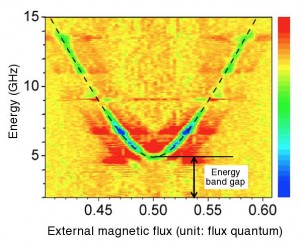
Oleg Astafiev and his colleagues at the RIKEN Advanced Science Institute (ASI) and NEC Smart Energy Research Laboratories have in a paper in Nature reported on the first direct observation of Coherent quantum phase slip, in a narrow superconducting wire of indium-oxide (InOx). Coherent quantum phase slip (CQPS), as this phenomenon is known, has long been limited to being just theoretical, an intriguing but until now unobserved parallel to the Josephson effect.
Unlike the Josephson effect were electric charges jump from one superconducting layer to another across an insulating layer, the behavior of the insulator and superconductor are reversed in this parallel theory. A magnetic flux, quanta jump from one insulator to another across a superconducting layer. Quantum tunneling of electrons in the Josephson junction is replaced in this parallel by the coherent “slip” of the phase, a quantum variable that, in superconducting circuits, plays a dual role to that of electric charge.
The electrical resistivity of a metallic conductor decreases gradually as temperature is lowered. In regular conductors, this decrease is limited by impurities and other defects in the material, so that even near absolute zero, some resistance is still present. In a superconductor, the resistance drops abruptly to zero when the material is cooled below it’s critical temperature. Among the most important applications of superconductivity is the Josephson junction, named after physicist Brian Josephson, who in 1962 predicted that a superconducting current could tunnel between superconductors separated by a thin insulating layer. This phenomenon, the Josephson effect, has been applied in a variety of areas including magnetometer design, voltage standardization, and quantum computing.

The researchers managed to observe the phenomenon in a narrow superconducting wire of indium-oxide (InOx). The wire was inserted into a larger superconducting loop to form a new device called a phase-slip qubit, were the superconducting layer was sandwiched between insulating layers of empty space. By tuning the magnetic flux penetrating this loop while scanning microwave frequencies, the researchers was able to detect a band gap in the energy curves for the two flux states of the system, just as theory predicts. This gap is a result of quantum mechanics, which prevents the two states from occupying the same energy level, forcing them to tunnel across the superconducting layer-and through a quantum phase-slip in the narrow wire-to avoid it.

Not only did the researchers at the RIKEN Advanced Science Institute and their collaborators, manage to demonstrate the world’s first-ever experimental demonstration of coherent quantum phase slip, and showing conclusively it’s existence. The successful experiment will most likely also lead to a new and exciting path for superconducting electronics for the future. The groundbreaking result sheds light on an elusive phenomenon whose existence, a natural outcome of the hundred-year-old theory of superconductivity, has long been speculated, but never actually observed before.
